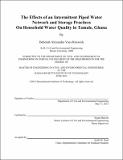The effects of an intermittent piped water network and storage practices on household water quality in Tamale, Ghana
Author(s)
Vacs Renwick, Deborah Alexandra
DownloadFull printable version (30.19Mb)
Other Contributors
Massachusetts Institute of Technology. Department of Civil and Environmental Engineering.
Advisor
Susan Murcott.
Terms of use
Metadata
Show full item recordAbstract
The United Nations Millennium Development Goals include a target to halve the number of people without access to "improved" water sources, which include piped water supply. However, an "improved" source of water does not necessarily indicate a safe source. The city of Tamale in northern Ghana has a piped water network that supplies treated water, but the system is intermittent and many users only have access to piped water several days per week. In order to have sufficient supply of water, users are forced to store large quantities of water in their homes, sometimes in unsanitary storage containers. Samples taken from households around Tamale indicate that there is widespread contamination of drinking water as indicated by total coliform, E. coli, and lack of chlorine residual. Examination of data from Ghana Water Company Limited, the local utility shows that water quality is being degraded between the treatment plant outlet and use by households. This degradation could be caused by low-pressure situations in the intermittent distribution system, allowing contaminants to enter the system. The contamination could also be caused by unhygienic water storage practices in the home, such as storing water in open containers and dipping unwashed hands into the water supply. Interviews conducted in 40 households show that many households do not practice hygienic water storage and handling. In the short term, it is recommended that local NGOs or local government agencies increase efforts to educate users about proper water handling and storage practices to decrease bacteriological contamination of drinking water in the home. In the long-term, it is recommended that the intermittency of the system be decreased by improving maintenance on pipelines and removing illegal connections.
Description
Thesis (M. Eng.)--Massachusetts Institute of Technology, Department of Civil and Environmental Engineering, 2013. This electronic version was submitted by the student author. The certified thesis is available in the Institute Archives and Special Collections. Cataloged from student-submitted PDF version of thesis. Includes bibliographical references (pages 67-69).
Date issued
2013Department
Massachusetts Institute of Technology. Department of Civil and Environmental EngineeringPublisher
Massachusetts Institute of Technology
Keywords
Civil and Environmental Engineering.